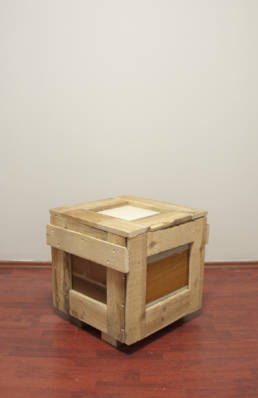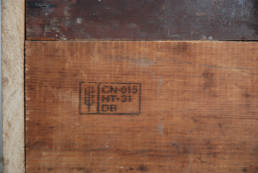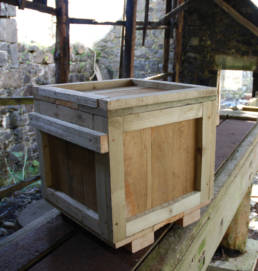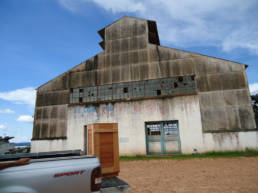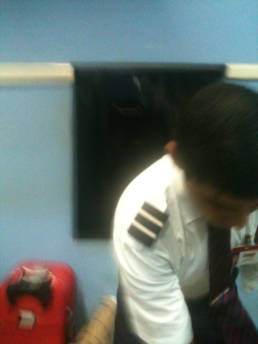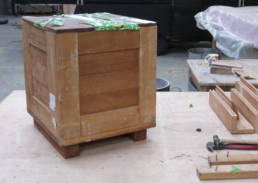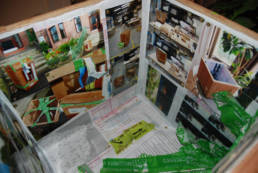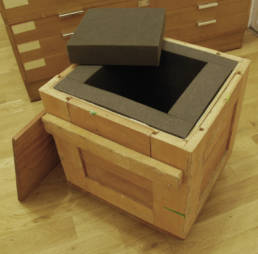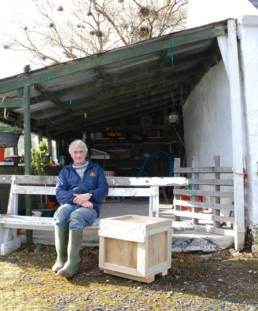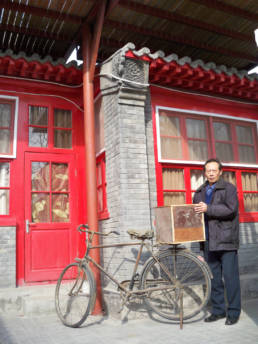Proposal for a Warehouse
or
Towards a Museum of Reorganisation
2011 / 2012
Wooden shipping crates
This project takes the form of a number of shipping crates, each one produced in a location where a rapid economic transformation is taking (or has taken) place; a transformation requiring coercive reorganisation at great human or social cost. The crates are made with materials produced locally (or materials with local significance) and with the help of people who currently live in the locations in question. Each crate, when padded on the inside could, in principle, be used to safely transport Robert Morris’s 1961 work, Box With The Sound Of Its Own Making. Between the wooden exterior and the interior padding, the crates are lined with printed email conversations, official documents and photographs relating to their construction and the journey they have made to Glasgow. The crates may be – and have been – exhibited, but the way I understand them is that they are active when they are in storage, and inactive when they are exhibited, thereby enacting a reversal in which they cease to be ‘live’ when they are public, rather than becoming live when they are public. In a warehouse (or any other storage situation) they do not look out of step with their surroundings; but unlike the other crates around them, they are displaying themselves rather than obscuring display items. There are four crates, one made in each of the following locations:
Fordlândia, Brazil
Fordlândia is a town in the Brazilian rainforest built at considerable expense by Henry Ford in the early twentieth century. Ford’s strategy was part utilitarian (taking control of the rubber supply for his tyres) and part ideological (he believed that industrialisation would succeed war as a colonising tool – Ford was a pacifist, but believed in American expansionism). As a result, the aesthetic of the town – white clapboard houses, grid streets, drive-in movie theatre and so on – was as important as its function, but was as alien and inappropriate to the environment as the economic model he failed to impose on the local infrastructure. The venture was a farce and a disaster; the town was abandoned and is now overgrown by surrounding jungle.
Colbost, The Isle of Skye, Scotland
The Isle of Skye was the site of a disastrous experiment in forced eviction, carried out by Norman MacLeod of Dunvegan in 1739, predating the Clearances (the forcible eviction of crofters, who were made to head to growing cities to seek employment in factories, the land being converted to industrial-scale farms) by over twenty years. MacLeod hired an Irish merchant, William Davidson, to moor his ship on the loch in the middle of the night, and send a gang of thugs to drag enough tenant crofters from their beds to fill his hold. The intention was to sell the captives as indentured labourers in the United States, but while Davidson was refitting his ship for the voyage in Donaghadee a small group escaped, and were found by the local magistrate before Davidson could recapture them. Despite attempts at a cover-up, the episode was traced back to MacLeod, and widely reported in Edinburgh, scuppering his political ambitions.
Istanbul, Turkey
This crate focuses on sites of former gecekondus, self-built neighbourhoods that were constructed by communities of economic migrants from Anatolia while Istanbul was industrialising in the 1950s. Gecekondus were built on government owned land and were tolerated as long as the city needed workers, beginning as shantytowns but eventually – with the addition of services and utilities – becoming integrated into the city’s infrastructure. As Turkey’s economy became more advanced, the land – in turn – became more valuable, and the gecekondus were (and are continuing to be) bulldozed to make way for gleaming office and residential real estate, the previous occupants being rehoused in hastily constructed tower-blocks at the margins of the city. For this crate, wood was gathered from the streets of districts that were in the process of being, or had recently been, cleared.
Beijing, China
The Beijing crate was built by Wang Youcheng, who was sent to Inner Mongolia to be ‘re-educated’ by the rural proletariat, so-called ‘rustication,’ which was part of Mao Zedong’s Cultural Revolution of the late-60s/early-70s. Wang was a high-school graduate, and therefore seen as part of the intelligentsia, but he also had a ‘contaminated’ family history in the form of a sister who lived in Taiwan. He was forced to cut reeds in a freezing lake, but escaped back to Beijing after hearing his mother was ill. He remained there in hiding for almost three years, unable to work nor claim rations and describes his struggles as ‘unimaginable.’ Wang built a crate using early 1970s furniture in the style of the one in which he carried all his possessions to Wuliangsu, over forty years ago.
This project was made possible by Jenny Richards, Gil Serique, Nick Carter, Xia Jie, Wang Youcheng, Dan Dubowitz, Can Altay, PiST (Istanbul), Collective (Edinburgh), Glasgow Sculpture Studios (Glasgow) and the Hope Scott Trust.
Exhibited in:
How to Turn the World by Hand
Collective, Edinburgh (3 Mar 2012 → 8 Apr 2012)
